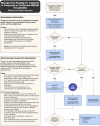Catatonia in anti-NMDA receptor encephalitis: a case series and approach to improve outcomes with electroconvulsive therapy
- PMID: 39564516
- PMCID: PMC11575251
- DOI: 10.1136/bmjno-2024-000812
Catatonia in anti-NMDA receptor encephalitis: a case series and approach to improve outcomes with electroconvulsive therapy
Abstract
Background: Anti-N-methyl-D-aspartate (NMDA) receptor encephalitis has been recognised to present with the syndrome of catatonia. In severe cases dysautonomia is representative of malignant catatonia. The treatment with benzodiazepines (BZDs) and electroconvulsive therapy (ECT) may decrease morbidity and mortality in patients presenting with anti-NMDA receptor encephalitis and catatonia.
Methods: This is a retrospective case series of eight patients with anti-NMDA receptor encephalitis treated with ECT. We use clinical prediction scores (Clinical Assessment Scale for Autoimmune Encephalitis [CASE] and anti-NMDAR Encephalitis One-Year Functional Status scores) to compare expected outcomes and observed outcomes.
Results: CASE scores in our group ranged between 5 and 19, with a mean score of 13.8 (median 15.5). NEOS scores ranged from 2 to 4, with a mean and median of 3. Of the eight patients, six had a favourable modified Rankin Score (0-2) at a follow-up of 8 to 12 months. Patients received an average of 29.9 ECT treatments in total.
Conclusions: Based on clinical prediction scores, this cohort had better than expected functional outcomes. We discuss the use of BZDs and ECT in these cases and propose a treatment algorithm for patients who present with catatonic syndrome in anti-NMDA receptor encephalitis.
Keywords: CLINICAL NEUROLOGY; ELECTRICAL STIMULATION; NEUROIMMUNOLOGY; NMDA; PSYCHIATRY.
Copyright © Author(s) (or their employer(s)) 2024. Re-use permitted under CC BY-NC. No commercial re-use. See rights and permissions. Published by BMJ.
Conflict of interest statement
No, there are no competing interests.
Figures
References
LinkOut - more resources
Full Text Sources


